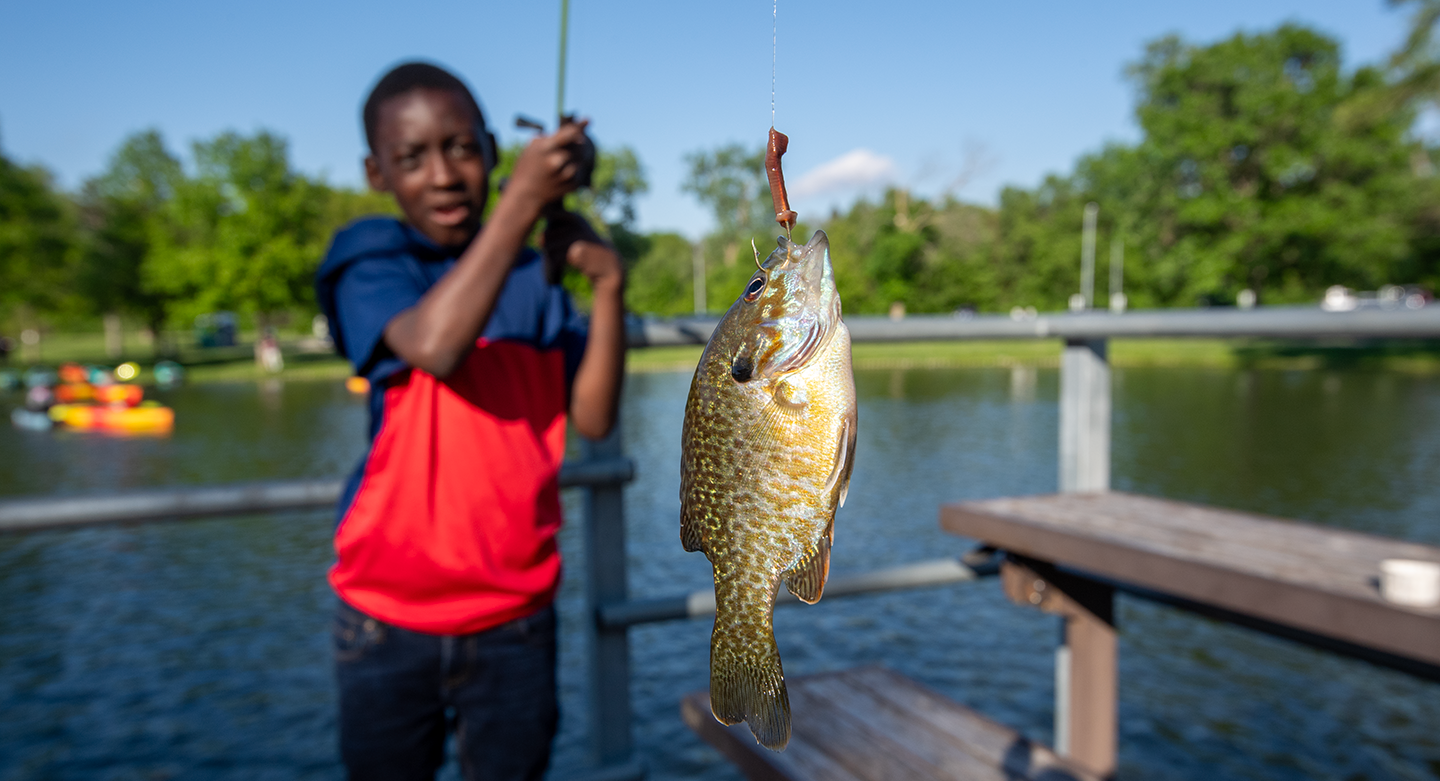
By Greg Wagner
Summertime bluegill fishing is as American as apple pie, hot dogs and baseball. However, some folks dismiss or look down on bluegill fishing. Well, here are eight reasons for you to consider catching bluegill this time of year.
1) Available just about everywhere.
The bluegill, Lepomis macrochirus, is native to Nebraska and inhabits nearly all ponds, reservoirs, lakes, old river oxbows and meandering creeks. If there’s a decent-sized pool of water available, chances are, there are probably bluegill in it!
2) Easy to find.
Pick a spot along a bank and cast out into the water, almost. The bluegill is a fish of the shallows and exists near the shoreline around vegetation, structure, timber and even sometimes where there isn’t any aquatic habitat. Look for bluegill around or near their plate-shaped spawning bed nest depressions. According to Daryl Bauer in our Game and Parks Fisheries Division, bigger bluegill tend to still hang out in the deeper, darker water just beyond those depressions as well as along the deeper edges of weed, moss and algae lines in summer. Bauer says larger “bull” bluegill are normally risk takers and like to hang out in slightly deeper water due to their size. Bauer adds that those bigger fish tend to go a bit farther from aquatic cover and vegetation for better feeding prospects. From a conservation standpoint, he suggests releasing those “bulls” to swim another day.
3) Simple equipment and cheap bait will catch bluegill.
Basic fishing gear will suffice for catching bluegill. Really, it’s whatever you may have on hand at home. I like to use an ultralight rod and reel with light line, small hooks, small steel weights and small bobbers. Regarding bait, the bluegill is certainly not picky. Anything from nightcrawlers (earthworms) dug in the vegetable garden to canned sweet corn kernels bought at the supermarket to grasshoppers caught in the weeds will work just fine. When it comes to small artificial lures for the ‘gills such as small jigs, those that are of contrasting colors like black and yellow usually prove best to use.
4) Bluegill are bold biters and strong fighters.
Bluegill are prolific in nature and a numerous prey species. They are a schooling fish, and quick, competitive, aggressive feeders. One of the more interesting traits of the bluegill is how bold they can be. Many bluegills have no fear of the angler trying to catch them, even in clear water! They also have a reputation for being one of the strongest fighters in the fish kingdom (per square inch or ounce, that is) typically swimming at hard right angles with their round, flat bodies after being hooked. Hence, bluegill are ideal for kids to catch!
5) Hot action in the summer heat.
Some of the best bluegill fishing actually occurs when the intense summer heat and humidity have descended on us. From now through Labor Day, bluegill save the day for many families vacationing near water in our state park lands and wanting to catch fish. After all, bluegill are cold-blooded creatures. That means their body temperature varies with their surroundings and they get more active and hungry when the water is warmer. For hardcore anglers, catching bluegill during the daytime for nighttime channel catfishing cut bait (where possible) also offers some productive action when temperatures rise plus a bit of nostalgia as well.
6) Great for beginner fly-fishing.
Even though you might think fly-fishing is reserved for trout, it is also one of the most effective, exciting ways to catch bluegill, especially in the summertime. Small insects are a major portion of the bluegill’s diet, and an artificial fly resembling one of these insects is usually irresistible to it! According to the Cornhusker Fly Fishers, a premier fly-fishing organization, the Zug Bug, an impressionistic pattern that can appear to mimic all types of aquatic insect larvae, is an excellent summer fly to cast for panfish like bluegill. Black and red ant patterns also work well. Really, you can easily catch bluegill on just about any fly imitator you have in your box if you present it to them properly. Bluegill particularly offer superb training for beginning fly anglers!
7) Bluegill make for fun paddle craft fishing.
Anglers with kayaks, paddle boards, canoes, etc. have a blast for fishing for bluegill! Many of these anglers do what is called “softbaiting” for ‘gills. This involves using smaller weighted jigheads and rubber or plastic lures that resemble baitfish, earthworms or aquatic organisms. Softbaiting reduces the need to take messy live baits on board and allows for quick, repeated casts, catches and releases. These stealthy anglers are able reach difficult places with their versatile paddle craft and find much excitement fighting a game fish like a larger, scrappy bluegill as it tries to pull the lighter vessel through the water.
8) Fillets make excellent table fare.
Bluegill fillets are absolutely delicious rolled in some flour and seasonings, then given a swim in hot cooking oil. The flesh of bluegill is firm, flaky, and well flavored. Bluegill are also are a healthy food selection to eat. That’s because they’re lower in the food chain and tend to be smaller so they’re less likely to be the subject of consumption advisories than larger predatory fish.
Next time you are going fishing, don’t forget about the bluegill. It may be a smaller fish, but it’s qualities make it a great catch in every sense.
